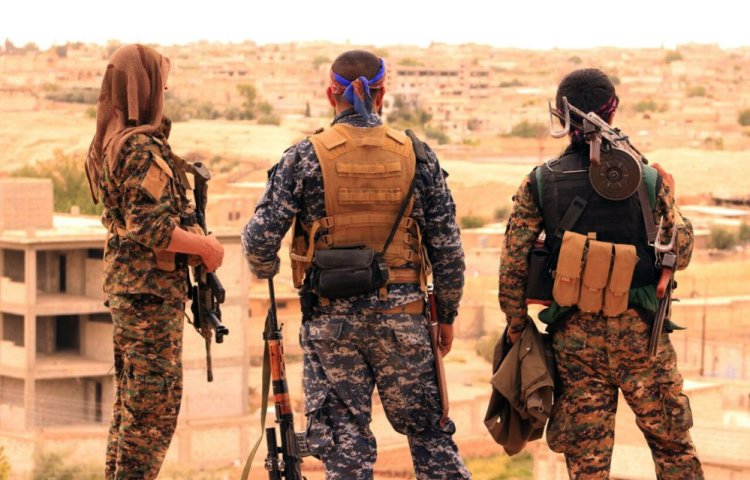WASHINGTON — Trump administration officials, anticipating the defeat of the Islamic State in its de facto Syrian capital of Raqqa, are planning for what they see as the next stage of the war, a complex fight that will bring them into direct conflict with Syrian government and Iranian forces contesting control of a vast desert stretch in eastern Syria.
To some extent, that clash has already begun. Unprecedented recent U.S. strikes against regime and Iranian-backed militia forces have been intended as warnings to Syrian President Bashar Assad and Tehran that they will not be allowed to confront or impede the Americans and their local proxy forces.
As regime and militia forces have begun advancing eastward, senior White House officials have been pushing the Pentagon to establish outposts in the desert region. The goal would be to prevent a Syrian or Iranian military presence that would interfere with the U.S. military’s ability to break the Islamic State’s hold on the Euphrates River valley south of Raqqa and into Iraq – a sparsely populated area where the militants could regroup and continue to plan terrorist operations against the West.
Officials said Syrian government claims on the area would also undermine progress toward a political settlement in the long-separate rebel war against Assad, intended to stabilize the country by limiting his control and eventually driving him from power.
The wisdom and need for such a strategy – effectively inserting the United States in Syria’s civil war, after years of trying to stay out of it, and risking direct confrontation with Iran and Russia, Assad’s other main backer – has been a subject of intense debate between the White House and the Pentagon.
Some in the Pentagon have resisted the move, amid concern about distractions from the campaign against the Islamic State and whether U.S. troops put in isolated positions in Syria, or those in proximity to Iranian-backed militias in Iraq, could be protected. European allies in the anti-Islamic State coalition have also questioned whether U.S.-trained Syrians, now being recruited to serve as a southern ground-force vanguard, are sufficient in number or capability to succeed.

One White House official, among several who spoke on the condition of anonymity to discuss Syria planning, dismissed such concerns, saying: “If you’re worried that any incident anywhere could cause Iran to take advantage of vulnerable U.S. forces … if you don’t think America has real interests that are worth fighting for, then fine.”
The official said the expanded U.S. role would not require more troops, comparing it to “The Rat Patrol,” the 1960s television series about small, allied desert forces deployed against the Germans in northern Africa during World War II.
This official and others played down reports of tensions over Syria strategy. “No one disagrees about the strategy or the objectives,” said a second White House official. “The question is how best to operationalize it.”
The Pentagon, not the White House, made the decision to shoot down Iranian drones and a Syrian fighter jet in response to their approaches to or attacks against U.S. forces and their Syrian allies, this official said. “They shot down an enemy aircraft for the first time in more than a decade. That’s accepting a high level of risk,” the official said. “We’ve done quite a lot since April that the previous administration said was impossible without the conflict spiraling.”
Ilan Goldenberg, a former senior Pentagon official now in charge of the Center for a New American Security’s Middle East program, agreed that the Obama administration “over-agonized” about every decision in Syria.
But Goldenberg faulted President Trump’s administration with failing to articulate its strategy. “It has been the worst of all worlds,” he said. “A vagueness on strategy, but a willingness to deploy force. They are totally muddying the waters, and now you have significant risk of escalation.”
Trump promised during his campaign to announce within his first month in office a new strategy for defeating the Islamic State. That strategy remains unrevealed, and for several months Trump appeared to be following President Barack Obama’s lead in avoiding Assad, Iran and Russia and continuing a punishing assault on Islamic State strongholds elsewhere in Syria, as well as in Iraq.
In April, Trump broke that mold with a cruise-missile attack on regime forces after their use of chemical weapons against civilians. Assad and his allies protested but did little else.
More recently, however, there have been direct clashes between the U.S. and the regime. Trump’s campaign calls to join forces with Russia against the Islamic State have largely disappeared amid increased estrangement between Washington and Moscow and investigations of Trump associates’ contacts with Russian officials.
Despite U.S. warnings, regime and militia forces have moved toward the Syrian town of At Tanf, near Iraq, where U.S. advisers are training Syrian proxies to head toward Deir al-Zour, the region’s largest city, controlled by the regime and surrounded by the Islamic State.
Send questions/comments to the editors.



Success. Please wait for the page to reload. If the page does not reload within 5 seconds, please refresh the page.
Enter your email and password to access comments.
Hi, to comment on stories you must . This profile is in addition to your subscription and website login.
Already have a commenting profile? .
Invalid username/password.
Please check your email to confirm and complete your registration.
Only subscribers are eligible to post comments. Please subscribe or login first for digital access. Here’s why.
Use the form below to reset your password. When you've submitted your account email, we will send an email with a reset code.